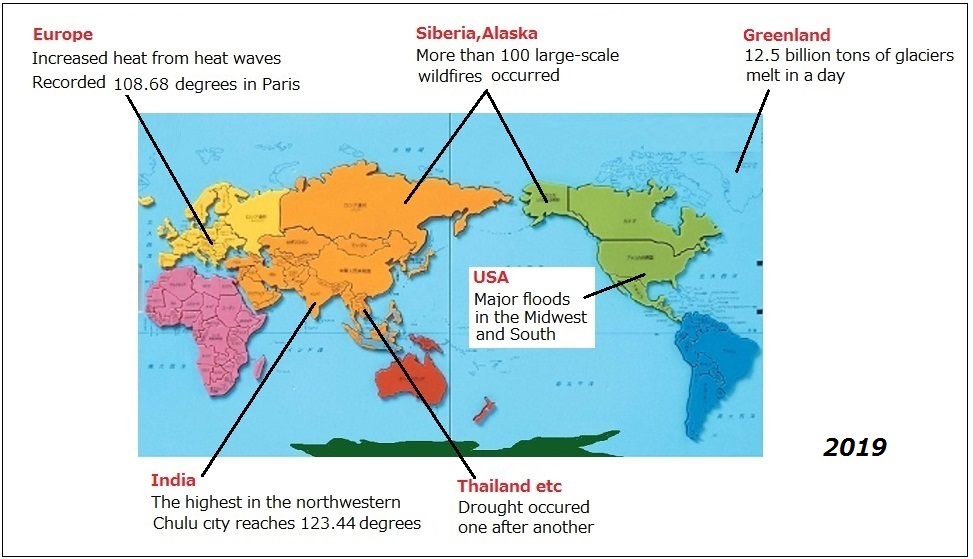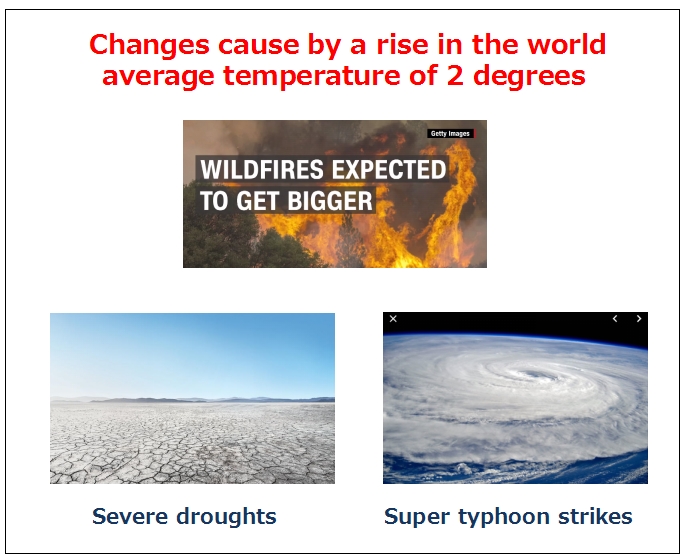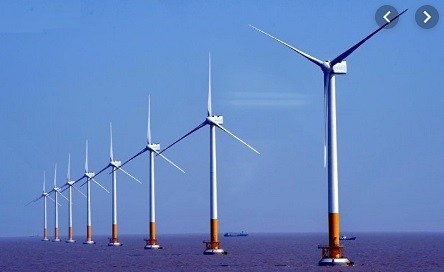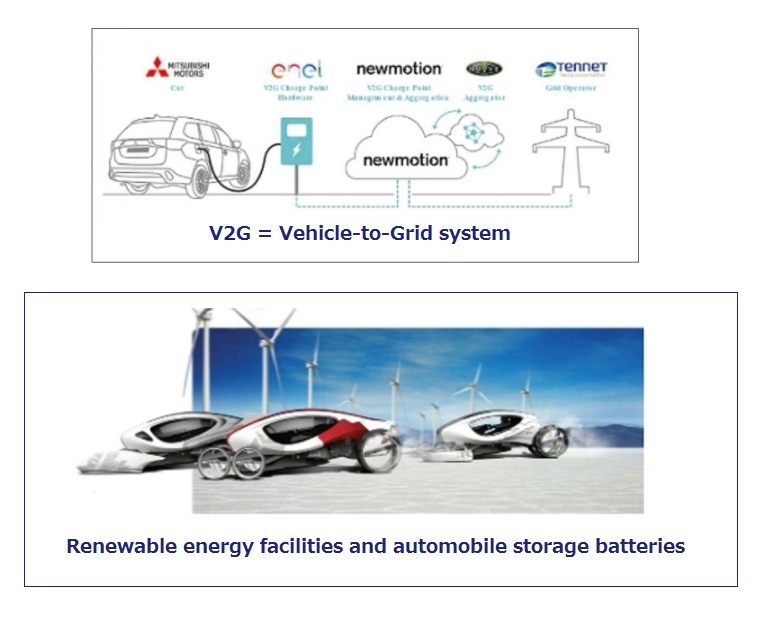Dealing with grave Environmental Issues
with wisdom and mercy

One of the biggest threats facing
the entire human society today is
environmental problems.
In particular, there are three major
environmental destruction problems.
1 Warming issue
2 Subtropical rain-forest drastically
3 decreasing problem
Plastic garbage problem
There are other things, but here I will
focus on the “Global Warming Problem”
of 1.
2 and 3 will be added later.
Unstoppable global warming
Even in 2019, Global Warming has
progressed in various parts of the
world. The actual situation will be
described below.
In Europe, over 104 degrees Fahrenheit,
and in the Arctic Circle and Siberia,
glaciers melted and wildfires occurred.

NOAA(1) announced on August 15 that
the average temperature in July of the
world exceeded 33.71 degrees (F),
the highest ever.
(1) NOAA―National Oceanic and
Atmospheric Administration
The World Meteorological Organization
also announced that the average global
temperature in June this year was 61.52
degrees (F), the hottest June in 140 years
of observation.
The heat wave also extended to Greenland,
which is located in much of the Arctic Circle.
There, 12.5 billion tons of glaciers melted in
a single day, August 1, and It became a
record high as the amount of melting
per day.
The US media reported that the amount
of ice melted in June and July alone
reached 240 billion tons. As a result,
the Arctic sea ice area in July became
20% smaller than the average, the
lowest ever. In the future, sea level rise
is inevitable.

“In Greenland, icebergs break and
large chunks can cause tsunami that
can swallow a coastal village.
Sweden’s highest peak, Kebunekaise,
has recently melted at the tip of the
glacier and is no longer the highest
peak.”【New York Times】
“In the past, such a heat wave occurred
once every 10 years, but now every
2 years,” points out Francois Marie Brion,
deputy director of the Institute for
Climate and Environmental Sciences
(LSCE).” 【Same as above】
(Below is an article from Yahoo News
on July 19, 2019)
At the end of July, the highest
temperatures were recorded in various
parts of Europe such as France, the
UK and Germany.
In Paris, on July 25, it was 108.68
degrees F, the first time in 72 years.
In France, in the second half of June
2019, a record heat that exceeded
the average temperature by 50 to
60 degrees F continued, and the
main wine producing area Bordeaux
recorded 106.16 degrees F.
In addition, days with little rain
continued. For example, in Paris,
it didn’t rain from June 21 to mid-July.
In this period, it has become the
least rainy in the 140 years that
have been observed.
Due to the high temperature and
drought, wildfires occurred in the
south of France, the production of
wine grapes and corn decreased
dramatically, and there was also
an impact on nuclear power
generation due to insufficient water.
However, it is expected that the heat
will ease after july 26th and there will
be rainfall.

In addition, on July 24, the highest
domestic temperature record was
updated in Belgium, Germany and the
Netherlands. 【July 25 AFP】
In Belgium, 103.82 degrees F,
the highest domestic temperature,
was observed at Kleine-Brogel station.
It rewrote the record observed in
June 1947.
In Germany, 104.9 degrees F was
observed in western Geilenkirchen,
exceeding the highest domestic
temperature of 104.54 degrees F so far.
In the Netherlands, 101.84 degrees F
was observed at Gilze-Rijen station
in the south, updating the record
75 years ago.
Not only in Europe, but also in Alaska
Anchorage, the highest temperature
in observation history was updated to
89.9 degrees F.
In winter in Australia, too, water
restrictions were implemented from
June due to lack of water. 【July 25 AFP】
Forecasting future global
average temperature rise
According to experts’ analysis of
future global warming predictions,
the world average temperature
will rise by 4 degrees in 2100 if no
measures are taken in the future.
In addition, if all possible measures
are taken, it is said that there is a
possibility that it can be suppressed
to 1.5 degrees.
According to the United Nations
Intergovernmental Panel on Climate
Change (IPCC), about 105,000 species
of ecosystems were examined, and
only an average temperature rise of
2 degrees resulted in 18% of insects,
16% of plants, and spine 8% of animals
lose more than half of their habitat.
In particular, coral reefs are said to
be almost extinct with a two-degree
rise. (Destruction of corals depends
on the ocean becoming acidic due
to increased CO2)
 In addition, submergence of islands
In addition, submergence of islands
due to rising sea level,
flood due to abnormal heavy rain,
increase of super-large typhoons,
increased drought and concomitant
food shortage and water shortage,
heat wave hit on a global scale,
and abnormal rise in temperature, etc.
Various harmful effects will occur in
various parts of the world.
The world’s average temperature has
already risen 1 degree since the
Industrial Revolution 100-150 years
ago. There is only 1 degree till 2 degrees.
It was the “Paris Agreement Agreed /
Cup 21 In December 2015 (2) ,” that
was set to limit this to 1.5 degrees.
If you left untreated without taking
sufficient measures, the world’s
average temperature will exceed
2 degrees by around 2040.
( IPCC Intergovernmental Panel )
For this reason, various countries
have taken various measures to
prevent global warming.
(2) “Paris Agreement”―
The agreement concluded by
countries all over the world to
tackle climate change at the
International Conference on the
Framework Convention on
Climate Change (COP21) held in
Paris, France in December 2015.
UN Climate Action Summit
in New York 2019

On September 23, 2019, the United
Nations Climate Action Summit on
the theme of environmental issues
was held in New York, USA.
At the summit, representatives from
various countries and companies
gathered to discuss their efforts and
solutions.
The aim is to reduce the world’s
average temperature to 1.5 degrees
by 2030, further reduce carbon
dioxide emissions by half, and make it
virtually zero by 2050.
Many scientists pointed out that
in order to keep the world’s average
temperature down to 1.5 degrees,
carbon dioxide (CO2) needs to be
reduced by half.
The key to reducing carbon dioxide
is “Corporate Activities” that account
for 70% of the world’s carbon dioxide
emissions.
At the summit, a 16-year-old
Swedish girl, Greta Toonberg,
enthusiastically urged the world’s
companies and national leaders not
to emit carbon dioxide CO2, which
causes global warming.
Also, UN Secretary General Guterres
commented, “The strongest request
is to invest in climate change (invest
to preventing global warming) and
stop investing in fossil fuels (oil, coal,
natural gas, etc.).”
Banks will no longer finance
companies that do not consider
environmental issues
During the week of the summit,
the heads of the world’s major
banks gathered at the UN
headquarters. And they signed
a declaration that they will
no longer finance companies and
projects that do not consider
the impacts of climate change.
This fact is enormous for the
global business community.
“Banks have a huge influence,”
said BNP Paribas (3) Environmental
Director Laurence Pessez.
She also announced that
“we will finance approximately
$ 16.71 billion for renewable energy
by next year.”
(3) BNP PARIBAS
An organization of climate initiatives
initiated by the BNP Paribas
Foundation in 2010, its purpose is to
promote understanding of climate
change and its environmental impact.
Under this initiative, as of June 2017,
10 international research teams
have already promoted climate
research and promoted climate
change awareness activities for
more than 200,000 people.
Countermeasures for global
warming
Next, regarding global warming
countermeasures, the most effective
countermeasure for preventing
global warming is to reduce carbon
dioxide / CO2 emissions.
But why the increase of CO2
becomes the cause of global
warming?
It is because the heat of the earth
warmed by sunlight escapes into
space when left untreated, so
carbon dioxide preserves the heat
and keeps them warm enough for
humans to live. However, if the
carbon dioxide increases too much
by burning a large amount of oil,
coal, natural gas, etc., and it stores
too much heat, the earth will become
hot and the “warming issue” will
occur. Therefore, as a solution to
reduce carbon dioxide, development
of “Renewable Energy”(4) such as
solar power and wind power
generation that does not emit carbon
dioxide becomes indispensable.
(4)Renewable Energy―
Unlike fossil energy, which is a
finite resource such as oil, coal,
and natural gas, it refers to energy
that is always present in nature,
such as part of earth resources
such as sunlight, wind power, and
geothermal heat. Its major features
are three points:“do not emit CO2,”
“do not run out,” “exist anywhere.”
I will basically explain the solutions
to global warming in the following
two points.
The first is specific measures that
companies, citizens, and nations
should take directly. The second is
a fundamental solution by acting
using the “law of the origin.”
Renewable energy facilities in
China with dramatic growth
The first is specific measures that
companies, citizens, and nations in
each country should take directly.
In particular, the progress of renewable
energy in China is remarkable.
According to IRENA (International
Renewable Energy Agency), in China,
during the 10 years from 2008 to 2018,
the amount of power generated by wind
power has expanded to 22 times, and
the solar power has expanded rapidly
to just under 700 times.
For example, in the suburbs of Shanghai,
China, there is a “Solar Panel Belt” that
gathers companies that produce silicon
parts, glass, cables, etc. for solar panels
over a straight distance of 150 miles.
Among them, the world’s sixth largest
“Longi Solar” has a huge factory that
can cover 70% of Japan’s electricity
demand. Solar panels made in China are
30 to 50% cheaper than those made
in Japan, with a global market share of
71% in 2017. Japan, the former leader,
is now 2%. (I will talk about the situation
in Japan later)

China has also made remarkable
progress in wind power generation.
For example, in Chinese company
Envision, the world’s fifth largest
wind power company in Shanghai,
China, Dozens of operators are
monitoring a 100 million kilowatt
facility comparable to Japan’s total
renewable energy generation.
The company’s system is connected
to 50 million domestic devices such
as electric vehicle (EV) charging
facilities, elevators, and room
temperature sensors. Based on the
information gathered, they will grasp
and carry out implement power
demand prediction, appropriate power
generation and control, and till failure
prediction.
The background of the rapid
acceleration of the development
and diffusion of renewable energy
in China is due to the strong backing
of the Chinese government. In China,
once the manufacturing industry, etc.
used to provide almost all of its power
source by thermal power generation
due to rapid industrialization.
As a result, a large amount of carbon
dioxide was emitted, leading to a large
amount of “Toxic yellow photochemical
smog” in big cities such as Beijing.

For this reason, Xi Jinping highest
leadership, in the high-tech industrial
development policy (China manufacture
2015), positioned the renewable energy
in the top priority areas. And they aimed
to raise the combined ratio of wind and
solar power to just under 30% in 2030
from just under 10% in 2018.
In the future, the international community
should make full use of China’s renewable
energy development and technologies
as described above for global
environmental measures.
China is currently adjusting issues
such as “US-China trade friction” and
“Large-scale protests in Hong Kong,”
but they will eventually finish its
adjustment and regain its calmness.
Then, the international community
should actively promote environmental
measures in cooperation with China.
China has launched the “Belt and Road
Initiative” policy, exporting renewable
energy equipment and its know-how
to many developing countries, and
forming business alliance projects.
Therefore, if international cooperation
for peace is established, it will be a
great force in promoting global
warming countermeasures.
US renewable energy situation
Next in the US, in 2017, Google in
the US purchased over 7 billion
kilowatt hours of electricity from
solar and wind power plants. This is
70 times the amount of 100 million
kilowatts of Chinese company
“Envision” mentioned earlier.
And Google covered all of its annual
electricity consumption with
renewable energy.
In the United States, companies
are extremely aware of global
warming countermeasures.
The Trump administration withdrew
the “Paris Agreement,”
an international framework for
global warming countermeasures,
but the American society as a whole
is active in environmental measures.
Many companies invest there.
In particular, major information
technology (IT) companies such as
Apple and Google are actively using
renewable energy. In that background,
the power cost of renewable energy
is extremely low.
The total generation capacity of
renewable energy in the US has
doubled in the 10 years to 2018.
One of the reasons is that the power
generation cost can be set low.
The cost of onshore wind power,
for example, in a windy state in the
middle south is 2-3 cents per
kilowatt hour. Much cheaper than
the average nuclear 14 cents.
Cheap electricity is suitable for
major IT companies such as Google,
which has many servers.

Kate Gordon, director of the California
Governor’s Planning Office, said:
“California is one of the first states
to set standards for power companies
to supply a certain amount of electricity
from renewable energy. By 2045,
the “SB100” law was enacted in which
all electricity used was supplied by
a power source that does not generate
carbon dioxide (CO2). This is the basic
measure that determines all renewable
energy policies.”
However, “California’s renewable
energy ratio currently exceeds 30%,
but renewable energy generation is
intermittent. Therefore, it requires
a lot of storage capacity,” she says.
As a result, California mandated the
introduction of a certain amount of
storage batteries. And Gordon
expresses the following determination.
“No matter how the US government
policy changes, our efforts will not be
affected by it.”
As described above, in the United
States, the proactive introduction
of renewable energy by the state
government and private companies
has made the United States
independent in terms of energy.
One of the strengths of the United
States is that “Innovation” led by
the private sector occurs one after
another.
European circumstances
What about Europe?
For example, in Denmark of the
Nordic country, big windmills are
noticeable everywhere.
Wind power is now the main power
source for over 40% of the country.
By 2050, plans will be made to
separate from fossil fuels such as
oil and coal, and to introduce large
amounts of renewable energy.
In a facility near Copenhagen in the
capital, a device called an “Electrolyzer”
converts surplus electricity in the
power grid into hydrogen.
When there is surplus electricity
from wind power generation,
water is electrolyzed and stored as
hydrogen. When electricity is
insufficient, the hydrogen reacts
with oxygen to extract electricity
for use.
In Europe, where resources are
scarce, rely on imports for much
of the fossil fuel. A large amount
of natural gas is also supplied
from Russia through a pipeline.
In order to increase the
self-sufficiency rate, they have
been working on renewable energy
since the 1980s, but the intermittent
nature of renewable energy is
an issue. Easy to be affected by the
weather. Therefore, attention was
focused on the development of
technology that uses electricity to
produce hydrogen and store it as
hydrogen. At present, large
companies such as Denmark’s
Oersted and France’s Engie have
started their business.
Another contrivance to make full
use of renewable energy in Europe
is that a number of power
generation facilities have built
a “Mega-Flexible Network” of
power that moves as if it were a
huge single power plant.
For example, Kraftwerke, German
western Cologne, operates about
8000 power plants in one bundle.
The company is the largest
“Virtual Power Plant (VPP)” with
a total power generation capacity
of 7 million kilowatts, equivalent to
seven nuclear power plants.
Thus, in Europe, power is supplied
through a power grid that crosses
borders. The EU as a whole has
good power compatibility, and the
share of renewable energy in the
EU’s electricity consumption has
exceeded 30%.
On June 21, 2019, the European
Union (EU) President Tusk expressed
his willingness to achieve zero
emissions of greenhouse gases by
2050. The EU, whose top priority is
to combat global warming, is
determined to turn most of its
electricity into renewable energy.
According to the UN Environmental
Plan, the EU’s renewable energy
research and development costs in
2017 were $ 2.7 billion, the highest,
exceeding $ 2.1 billion in the US and
$ 2 billion in China.
Japanese circumstances
Japan’s solar technology and its spread
increased for a period of time, but in
2012, the Tohoku big earthquake and
tsunami occurred, causing a major
accident at the Fukushima nuclear
power plant. Since then, the
government and power companies
have focused on restoring power
shortages. As a result, the purchase
price of sunlight could not be set low.
Also, in 2014, two years after the
Fukushima nuclear power plant, major
Japanese power companies stopped
purchasing electricity generated by
renewable energy companies only for
above a certain amount.
As a result, power producers and
manufacturers that have previously
generated a large amount of electricity
from sunlight and have been purchased
by power companies, could no longer
continue their business. And many
solar renewable energy companies
were unable to become independent
as an industry, and many companies
were out of business.
I will discuss the details of Japan’s
climate change measures and
renewable energy in another paper.
See “Details of the renewable energy
situation in Japan“
●●
●●
●●
Two new projects promoted in Japan
As a result, as of 2019, many renewable
energy businesses in Japan are far
behind the world in the field of solar
and wind power.
At present, Japan is promoting research
and planning for CO2 reduction in a
completely different way.
New promising projects are being
promoted in several ways. Here, I will
talk about a “CO2 reuse plan”, and
“V2G = vehicle-to-grid,” which
is attracting attention from around
the world as moving storage batteries
and transmission networks.
Planning to produce another
substance using CO2 in reverse
The first “CO2 reuse plan” is that large
companies in Japan are currently
focusing on research into technologies
for reusing carbon dioxide (CO2) to
produce various products from CO2.
For instance, 16 major Japanese
companies such as “Mitsubishi
Chemical” and “J Power” currently aim
to establish technology to collect
carbon dioxide (CO2) from power
plants and use it as raw materials to
produce clothing, building materials,
fuel, etc. This is the concept that
if CO2 is used in reverse to change
to another substance or product and
reduce them, it will lead to global CO2
reduction.
Currently, technology to make
materials such as concrete using
CO2 as a raw material has already
been established.
However, at the present stage, the
manufacturing cost is too high and
commercialization has not been
achieved. But in the long run, the
concept is indeed a great concept.
If a highly convenient product can
be manufactured using CO2 as a
raw material and established as a
global industry, it can greatly
contribute to the global reduction
of carbon dioxide.
About V2G=Vehicle-to-Grid
Another strength of Japan is
“development of power storage
technology” that is essential for
intermittent renewable energy.
For example, in Japan,
“V2G = Vehicle-to-Grid” system
technology that uses electric vehicles
(EVs) themselves as storage batteries
is attracting attention from around
the world. According to “Tokyo
Foundation for Policy Research,”
currently, it is Japanese cars that are
mostly used in demonstration tests
of this system all over the world.

Vehicle-to-Grid(V2G) also acts
as a transmission line in addition to
the storage battery. This is why V2G
is called “Next generation
transmission lines” or “Transmission
lines with wisdom.”
Specifically, the transmission line that
sends electricity has the brains of AI,
and is a system that supplies optimal
power in various places. Vehicles
with large storage batteries, such as
electric vehicles and plug-in hybrid
vehicles, are in charge of the business.
The reason why a vehicle with such a
function is necessary is that an
ensuring of a “storage battery” and
a “stable power grid” becomes
necessary for the spread of renewable
energy.
As was also said by Kate Gordon of
California earlier, because the power
supply of solar power and wind power
generation is easily influenced by
the weather and various external
circumstances, and the supply is
always intermittent. However, storage
batteries are expensive and
performance is also a question.
In California, there is a situation
that does not spread to each
company unless the government
strongly mandates it. Therefore,
“installation of a stable and large-
capacity storage battery” becomes
always a big issue.
In addition, a stable “transmission
network” is an important issue for
renewable energy. In particular,
in a large land such as the United
States, it is essential to secure a
transmission network that can
sufficiently transmit power to
various locations. This is because
if the power grid is not sufficiently
secured, power outages are often
caused.
A hydrogen society that will
surely arrive
Currently, in Japan, research is
also being conducted on a system
that operates by connecting
“V2G = Vehicle to Grid” and
Hydrogen Vehicle (FCVs).
FCVs: Fuel Cell Vehicle
This is because, in the case of
hydrogen and a hydrogen vehicle
(FCV), there are the following merits,
unlike an electric vehicle.
① Hydrogen itself is suitable for
large-capacity power Storage and
mass transport. That is, a large
amount of power is stored and
transported as hydrogen.
② Unlike electric vehicles, hydrogen
vehicles do not take time to refuel.
③ Existing gas stations can be used
for refueling.
④Energy efficient is good.
⑤There is little noise.
The disadvantages of hydrogen
vehicles are as follows.
① Inferior to electric vehicles in
terms of the total energy required
from fuel production to driving.
② Infrastructure development is
not progressing.
③ High price.
④ The weight is heavy.
At the present stage, in order to
overcome the problem of ①, it is
said that the price of hydrogen
vehicles (FCVs) will not drop unless
a “high-pressure tank unnecessary
and low-cost durable fuel cell” is
developed . However, they will be
overcome in the near future.
Solving environmental problems
by the law of the origin
The second is the fundamental solution
by acting using the “law of the origin.”
In order to solve environmental problems
using the law of the origin, it is necessary
to exert the wisdom power of Act ① to
correctly analyze the meaning of this
problem, the current situation, and the
progress of countermeasures in each
country. On that basis, it is necessary to
send Act ② mercy.
First, what is the nature of environmental
problems?
That is, this is the problem that must
be solved by humanity becoming one
across borders.
This is the essence of this problem.
For instance, even if a country insists
that “This is our borderline,” environmental
problems and Global Warming occur
across borders. Thus, countries and
countries are forced to cooperate across
borders to tackle this issue.
In addition, environmental problems
are not a problem that can be solved by
forming a federation or agreement
among several nations, like security
issues. Because even if 9 out of 10
countries have signed an agreement
on this issue, if one of the remaining
country opposes the agreement and an
environmental problem arises from that
country, the impact will extend to the
land of the remaining 9 countries.
In this way, the problem of global
warming and the problem of plastic
waste that scatters into the sea are
spreading beyond national borders.
Therefore, this is the problem that
must be tackled as a whole world.
In other words, it is a “common
problem” for the entire human race.
In this regard, environmental issues
are in common with AI robot weapon
problem. AI weapons (LaWS) are also
a critical problem faced by all humankind.
(See “In preparation for the near future”)
Considering these points, both
environmental issues and AI robot
weapon issues convey human society
the “necessity and urgency of
becoming one.” Those can also be
thought of as problems that occurred to
cause mankind to be aware of the
need to become one. They urgently say,
“Now it’s not time to fight for war,
conflict, territory and border issues.”
Conversely, considering environmental
issues from the standpoint of the
“law of the origin,” in order to make
companies, citizens, and the state
aware of the serious environmental
pollution and global warming issues
as a “serious threat,” the law of the
origin may not solve or stop them now.
The law of the origin will be able to
solve it, if wishes to solve it.
For instance, it can use the powerful
forces of nature to bring strong cold
waves to the South Pole and the
Arctic Circle and can increase ice.
However, if it does it now, neither
human society nor companies will
regard this problem as a “threat”
indefinitely. And they become the
sweet idea that “Environmental
problems will be solved naturally
if they are left alone,” and will not
realize that “Earth resources are finite.”
At the same time, they will not become
aware of the necessity and urgency
of international cooperation
indefinitely.
If that happens, it can lead to the
extinction of human society. Therefore,
if environmental problems have occurred
in order to make them aware of that,
the problems can be said to be
“phenomena / problems” that have
occurred to correct the wrong way of
thinking of those people.
Of course, the power of the law of the
origin acts strongly not only on social
problems but also on natural
phenomena such as weather and
temperature. Because the cause and
result managed by the law of the origin
is “all causes and results” of the
phenomenon world. The law of the
origin is rather better at controlling the
natural and space environment than
controlling social problems.
However, since the law of the origin
is just Passive, it will not work unless
you Actively issues a strong desire
and mercy to “protect the citizens and
the natural environment.”
Before I talk about it, I’ll talk about one
point of caution.
Don’t be deluded by the apparent
magnitude of natural phenomena
and national behavior
In our procedure for solving this problem
using the laws of origin, it is important to
first regard all of the following as
“movement of phenomena.” That is,
Global warming, environmental
destruction, the movements of
nations and companies that deal
with them, and changes in people’s
minds, etc. And then, we orient and
control these movement of
phenomena correctly under the law
of the origin that manages all
phenomena.
In that case, natural phenomena
and national actions occur on
a huge scale, so you should not be
deluded by them. No matter how
large the scale is, they are just
“phenomena movements.” From
the scale of cosmic and natural
phenomena such as Solar Flare
Explosion and Supernova Explosion,
it is insignificant.
On the other hand, the effects of
your good actions and Act ① and ②
under the law of the origin, are huge
and powerful forces.
Therefore, you don’t have to feel
a “Sense of Powerless”, “Fear”,
“Suspect”, etc. by being deluded by
natural phenomena and only the
apparent magnitude of national
behavior. It is the opposite.
As I said above.
Active good deeds create a
“firm orbit” in the world
Return the story to the theme
of Passive and Active.
Specifically, you—also we—need to
actively carry out Act ① and ② that
is the action of mercy and wisdom
in the form described above.
In other words, emitting a strong
desire and mercy to “protect the
citizens and the natural environment.”
And send it.
Then the law of the origin expands
and strengthens those good deeds
and creates a “firm orbit to solve
environmental problems” in the flow
of the international community.
When the orbit is completed, many
companies, citizens and nations
become aware of the orbit. And
they cannot be ignored it. And many
citizens and companies seriously
begin to think that global warming,
carbon dioxide increase, plastic
waste, and deforestation are serious
threats. And everyone comes to
take measures against it seriously.
National leaders also begin to feel
the necessity and urgency of
international cooperation in order
to truly solve environmental
problems. And they will come
together to solve this problem.
If I talk about this process with
an example, if there are thousands
army vehicles and when the
first vehicle starts running,
the “trace” that the vehicle has
passed will be created on the
ground. The trace is the “orbit.”
It is the same as all the remaining
vehicles chase after that “trace.”
Your active good will, and the action
of mercy and wisdom, become the
“Very First Leading Vehicle” by fusing
with the law of the origin.




